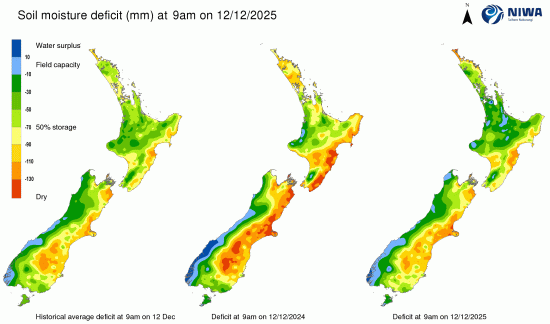Here's our summary of key economic events overnight that affect New Zealand, with news the two big policy set pieces today have been underwhelming.
First up today, the US Fed trimmed its policy rate by -25 bps as expected, bringing the target range to 3.75% to 4.00%. It issued a timid wait-and-see review which would be consistent with growing divisions within the policymaking committee, and growing worries that inflation is returning even as their labour markets weaken fast. Policy during stagflation requires a choice. One group wants the low-interest rate juice now, the other takes its inflation fighting mandate seriously.
Immediately after the announcement, the S&P500 dipped slightly, the UST 10 year yield rose a few basis points, and the USD changed little. The announcement had no impact on the gold price - nor the bitcoin price.
Earlier is was reported that mortgage applications rose +7.1% last week from the weak prior week, mainly on the back of pent-up refinance activity. Mortgage interest rates dipped but only minorly and were probably not the reason for the jump, which came after four consecutive weeks of decline. But having noted that, the s\mall rate dip did taken them to their lowest level in more than a year.
September pending home sales were soft, dipping -0.9% from the same month a year ago. This followed a +3.8% rise in August.
As expected, the Bank of Canada trimmed its policy rate by -25 bps to 2.25% in its overnight decision. It said that the Canadian economy is adjusting to tariffs and the sharp drop in demand for exports. The reconfiguration of global trade and domestic production is leading to higher costs. Total inflation there has been around 2%, while underlying inflation remains about 2½%. Following the decision, their central bank boss suggested their easing cycle may be over as they expect cost pressure to rise as their economy goes through this adjustment phase.
Malaysia's producer prices dipped slightly in September, down -0.8% from a year ago, but this was the least in six months as deflationary pressures seem to be past them now.
Meanwhile Singapore's producer prices are on the upswing now. They rose +3.7% in September from a year ago, the most in six months. It was more for factory products with those surging about double that rate on the year-ago basis.
In Australia, inflation is rising, and by more than expected. Their monthly indicator reported it rose +3.5% from the same month in 2024. The RBA meets next Tuesday to decide on its cash rate, and this seems to put the kibosh on the chance of any cut. In fact, a rate hike might get some airtime in their review.
At the APEC meeting in South Korea, all eyes are on the Xi-Trump meeting results - and how far Trump has backed down. (TACO) Of course, both sides will talk up the outcome, but early signs are that things like China's resumption of soybean imports from the US will be nominal at best. Trump's deals with both Korea and Japan have long-tail implications that may not work out for the US. But the short-term optics are all that matters at present.
Demand for air cargo transport rose for its seventh straight month, up +2.8% in September globally from a year ago, up +3.2% for international air shipments. This was led by the +6.9% rse in the Asia/Pacific region, and lagged by the -1.4% retreat in North America.
The UST 10yr yield is now at 4.03%, up just +4 bps from yesterday after the Fed announcement. The key 2-10 yield curve is now at +50 bps. Their 1-5 curve is now +2 bps positive and the 3 mth-10yr curve is now +7 bps positive. The China 10 year bond rate is up +1 bp at 1.76%. The Australian 10 year bond yield starts today at 4.26%, up +8 bps from yesterday. The NZ Government 10 year bond rate starts today at just on 4.08%, up +4 bps from yesterday.
Wall Street is up +0.1% on the S&P500 after the Fed announcement. Overnight, European markets were mixed between London's +0.6% rise and Frankfurt's -0.6% fall. Yesterday Tokyo ended up another strong +2.2%. Hong Kong dipped -0.3% again but Shanghai was up +0.7%. Singapore dipped -0.2%. The ASX200 was down a full -1.0% in Wednesday trade. The NZX50 ended unchanged in its trade yesterday.
The price of gold will start today at US$3993/oz, up +US$38 overnight and making back yesterday's drop.
American oil prices are up +50 USc from yesterday at just on US$60.50/bbl, with the international Brent price just on US$65/bbl.
The Kiwi dollar is now at just on 57.8 USc, and unchanged from this time yesterday. Against the Aussie we are down -10 bps at 87.7 AUc. Against the euro we are up +10 bps at 49.7 euro cents. That all means our TWI-5 starts today at just under 62.4 and up +10 bps from yesterday.
The bitcoin price starts today at US$111,195 and down -3.7% from this time yesterday. Volatility over the past 24 hours has again been moderate at just on +/- 2.0%.
Daily exchange rates
Select chart tabs
The easiest place to stay up with event risk is by following our Economic Calendar here ».
7 Comments
Population stats show some areas still growing strongly, Canterbury and Hamilton particularly
Physics stats say that ex fossil energy (a finite and increasingly contentious/contended source) we'll be struggling to feed 5 million.
And struggling to maintain our grid.
Including road-surfaces, and ultimately rail.
So whoever remains will need to be adjacent to food-production. Preferably walking distance.
Looking backwards if fraught.
If anything the population will increase faster in future as the rest of the world meltsdown, it's going to get interesting. If aussie temps keep rising, I won't be surprised to read that Australian boomers start retiring here and balance the trans-tasman flows
surely if the Boomers were to do that it would have already started? Post Boomer generations perhaps?
Southern oceans should moderate our temperature changes, but I would prefer a government strategy to maintain a population level 3 - 4 million. Probably too late for that though.
Apologies if I’ve interpreted your comments the wrong way.. Bill Gates has decided that there is no climate emergency after all.
From the Free Press..
https://x.com/TheFP/status/1983287508910633185
What will he do with his multiple bunkers and vast swathes of farmland he has bought up over the last 10-20years


We welcome your comments below. If you are not already registered, please register to comment
Remember we welcome robust, respectful and insightful debate. We don't welcome abusive or defamatory comments and will de-register those repeatedly making such comments. Our current comment policy is here.